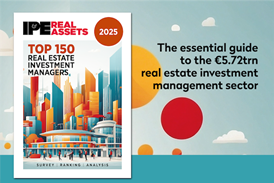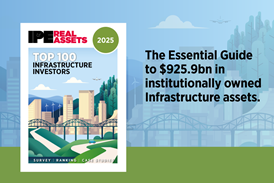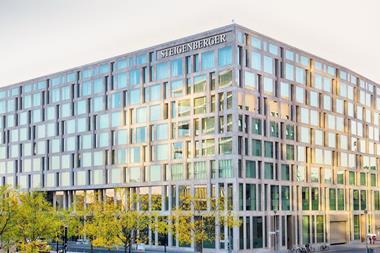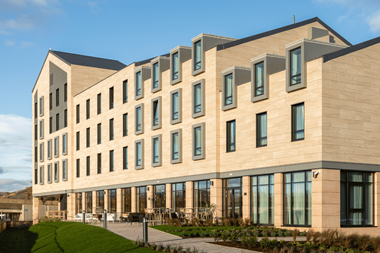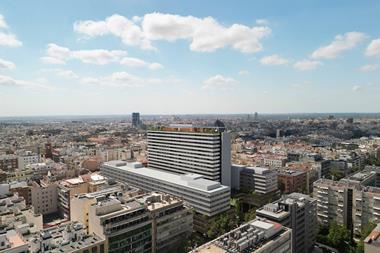Investors are betting on a post-Covid recovery, but inflation - and possible interest rate rises - are being watched carefully. Meanwhile, ESG-related value-add plays, prime shopping centres, and office occupancy levels are big talking points.

Real estate investors are factoring in a post-Covid recovery as they design investment strategies for 2022, even though the speed and shape of that recovery may not be known.
PropertyEU has assessed more than 15 Outlook 2022 reports published since November, and – somewhat reassuringly - not one weighs up the chances of a global financial crisis.
Global meltdown simply does not seem to be a realistic prospect, notwithstanding the unpredictable Covid situation, threats of war, trade supply issues, or financial spooks such as inflation and potential interest rate rises (see separate article under "Magazine Highlights"). Even corporate scares such as Chinese real estate company Evergrande, said to be struggling to make payments on more than $300 bn of loans, which some financial experts predicted would crash economies towards the end of last year, appear to be no real threat.
Instead, the main talking points are a return to growth, or at least more stability.
AEW’s 2022 European Annual Outlook states: ‘The central question for our 2022 European Outlook is, “How can real estate investors best re-align their investment strategy in a post-Covid world”?’
It says that since mid-2021, a ‘post-Covid rebound’ has already begun, which surprised on the upside.
Meanwhile, Lars Huber, CEO of Hines Europe, says: ‘I see 2022 as a year of consolidation as returns stabilise across the market and Covid-19’s influence on the economy starts to ease.’
BlackRock, the world’s largest asset manager, says: ‘After a year of disruption in 2020 and a year of adjustment in 2021, we are starting to look for a year of recovery in 2022, even in the absence of a clear conclusion to this global pandemic.’
It talks of this recovery being unlike a typical one. Post-Covid reopening is providing a short burst of growth, while the more fulsome recovery may take longer, given some loss of productive capacity in the past two years.
At the same time, the end of travel restrictions is occurring on a piecemeal basis. So, while the return of shoppers and workers may be swift, the return of tourists may take years. By region, this reopening is looking quite uneven as well, occurring a little faster in Europe and the US, but on a little more staggered basis in Asia.
Inflation reappears
Then the New York-based global firm says inflation has ‘made a comeback’. ‘Disrupted supply chains are adding to the costs of goods and distribution, likely for some years ahead. Out of this, we are seeing a fundamental reassessment of work, which is adding to wage costs in some services sectors, most notably in the US. Unlike recent upswing cycles, this round of inflation is coming from the supply side, rather than the typical later-in-the-cycle demand side pressures. Importantly, real assets remain a potent hedge against inflationary pressures, particularly where there are indexed rents or contracted revenue streams in place.’
BlackRock picks three ‘booming’ sectors from the whole spectrum of investible private assets. Perhaps there are no prizes for guessing logistics real estate is one of the sectors, to which the firm adds telecoms and renewables.
‘There is a lot to consider,’ says BlackRock, pointing to the joint forces of inflation and interest rates. Meanwhile, megatrends such as digitalisation and decarbonisation demand ‘immediate attention.’
‘Real assets investors should take careful note in a somewhat different market cycle, to take advantage of relentless structural change, to lean into the winning sectors and to hedge against rising inflation and higher rates,’ says the firm.
Real estate in demand
Real estate is still seeing institutional investors lean in, according to various outlook reports. To that extent there seems to be no change.
For example, the European Association for Investors in Non-Listed Real Estate Vehicles (Inrev) says ‘significant allocations’ are planned by institutional investors into real estate in 2022. Teaming up with fellow organisations, Anrev and Prea for its Investment Intentions Survey, Inrev says in 2022, 41% of planned capital deployment is targeting Europe, 39% North America (the US only) and 19% Asia Pacific.
Of the total expected volume of institutional investments this year, 41% is earmarked for non-listed real estate funds and 30% is planned for other non-listed real estate vehicles.
Up the risk curve
Potentially, investors are going up the risk curve, which is something new.
Inrev explains: ‘While historically investors have allocated most of their capital to core strategies, currently accounting for 83% of institutional portfolios, respondents demonstrated a notable uptick in risk appetite for new investments in 2022.’
This is particularly pronounced among those targeting Europe, with over half (57%) of respondents indicating a shift in preference toward value added strategies, the highest it has been since 2008. Conversely, only 30% preferred core strategies, down from 50% last year. Opportunistic strategies are preferred by 13% of respondents targeting European real estate.
Vanessa Muscara, head of research & strategy at Europa Capital, says for real estate investors, ‘acceptance of continued uncertainty is necessary to move forward’. This warrants a ‘diligent approach’ for low-risk investors, she adds: ‘For investors with a higher risk appetite, meeting double-digit return targets requires questioning the role that real estate plays for its “customers” in response to accelerated structural trends reshaping urban locations.’
For investors seeking opportunities in Europe, France (74%), Germany (71%) and the UK (69%) – the most mature and liquid markets – are once again the top three preferred destinations, according to Inrev.
Spain, the Netherlands, Denmark, Finland and Norway scored higher than in 2021 and above their long-term averages. Much of the appetite for these countries comes from European investors, while their counterparts in North America and Asia Pacific continue to favour the UK and, to a lesser extent, France and Germany. Spain stands out with a significant uplift in investor preferences from 45% in 2021 to 62% in 2022, putting it in fourth place overall behind the UK. Spain is the only second-tier destination to be equally preferred by both European and cross-regional investors.
Beds, sheds and meds
For the first time in the history of Inrev’s survey, investors selected industrial/logistics as the single top sector choice at 71% when investing in Europe, placing it ahead of offices and residential – both on 69%. It was the only sector in Europe to surpass its seven-year average score (67%), with growth likely coming on the back of ‘excellent performance results’ for the sector, driven by increased demand for logistics space during the Covid-19 pandemic. This is in sharp contrast to offices and retail which were 15% and 23% down from their long-term averages, with the remaining sectors more or less on par. Retail climbed back up from fifth to fourth place at 36%.
‘Beds, sheds and meds’ are still being touted by real estate firms as among the ‘winners’ for real estate investors – a view that has held sway for at least the past two years, probably longer. For 2022, BlackRock believes the divergence of performance will grow further between the ‘winners’ of residential and logistics, and the ‘losers’ such as hotels and retail. However, ‘distressed and dislocated’ real estate segments are beginning to show signs of ‘deep value’. ‘Getting hands on such assets requires on-the-ground expertise and off-market dealmaking capability,’ it adds.
Echoing PropertyEU’s cover story in December, AEW mentions the prospects for offices. ‘Covid’s working-from-home spike reduced office take-up as occupiers are still uncertain about their long-term real estate needs,’ the firm states. That said, it believes long-term impact on office demand will be ‘muted’ as employees will still be attending the office 50% of the time. It then identifies cities of local ‘resilience’ such as Marseille, Vienna, and Copenhagen.
Similar to BlackRock, AEW suggests residential property confirmed its strong supply fundamentals during the crisis. Residential and logistics drove overall investment volume. This is where it gets especially interesting. Prime shopping centre yields have widened by 120 basis points since 2018. So, what does AEW pick as an interesting opportunity? Prime shopping centres (see separate article under "Magazine Highlights").
Special situations
Picking up on interesting situations, real estate private equity lawyers at Ropes & Gray say levels of distress expected in late 2020/early 2021 did not materialise. Then, in the second half of 2021, the firm saw clients with opportunity-led approaches focus on more special situations.
London-based partners, David Seymour and Will Bryant, explain: ‘As we progress into 2022, we anticipate that we will see an increasing number of real estate special situations coming to the market, particularly in the hotel, hospitality and retail sectors. This will only increase as we progress towards the end of one of the longest economic cycles in living memory.’
Otherwise, they see a continuation of the ‘beds, sheds, and meds’ trend. ‘In 2022, we expect to see investors continue to target the real estate life sciences sector, focusing on the existing and emerging UK and European clusters for science and technology,’ they say. Furthermore, they predict more real estate investment firms will make equity investments into operating companies in specialist sectors to ‘get ahead of the race to scale’ and secure first offers and deal exclusivity with the most successful.
As is often the case, high-profile companies are approaching real estate strategies led by their own unique modelling. Hines, which has been so successful in recent years, has produced its Outlook 2022 proprietary research targeting ‘winning locations’. This year, it has exported its very granular research and data model to Europe and Asia markets.
Broadly, Hines sees Europe as a market that will be affected less by Covid-19 in 2022.
Alexander Knapp, CIO of Hines in Europe, says: ‘Covid-19 will still influence the course of the economy, but its influence will decrease over time.’
Strikingly, Hines’ Knapp, like AEW, identifies retail property as a particular beneficiary. He says: ‘As we gain a more accurate picture of how people will live in a post-Covid, or more accurately “Covid normal” world, areas of uncertainty should clarify, with retail being a particular beneficiary.’
Knapp says occupiers should feel more confident in making long-term decisions, including where they need to be physically present. ‘With greater clarity on demand for space comes greater clarity on rents, which should provide a floor on pricing.’
He adds: ‘The “beds and sheds” focus of the last few years will ease. Investors have had an almost obsessive “pie chart” approach to evaluating their portfolios based on weighting in the four main food groups. This should evolve toward a more sector-agnostic approach, where the quality of the individual assets and their locations become more important. A consideration of the pie chart will remain, but with less importance.’
Pricing across markets
The Hines research team shows Europe does still possess attractive pricing. It reckons some 63% of markets including residential have a ‘fair value to inexpensive’. That is better than 52% of Europe’s regions pre-Covid-19. Put simply, Hines says there are more pricing opportunities to add value in Europe than there were 18 months ago.
Explains Knapp: ‘Despite the current focus on Omicron, travel is likely to shift this year with US and Asian investors more likely to travel and invest in Europe. We anticipate European markets should look more attractive to US investors, because the speed of the US rebound has made pricing in Europe comparably more appealing.’
In a series of videos per country, Hines’ country heads set out their thoughts. In France for example, Xavier Musseau says the firm has a strong focus on last-mile logistics. ‘We think that the market is evolving very significantly at the moment and certainly in the years to come. We see penetration from e-commerce which is growing fast.’ The second focus is on residential. ‘We think we have something to bring to capacity – to offer scale.’
Andy Smith, country head of the Netherlands, says Hines has been focussed a lot on residential. ‘Generally speaking, there is a structural undersupply. Each year they set the targets for how many units are to be delivered and they are never met. What we are trying to do is build as many residential projects as we can.’ As with France, the firm has also spent a lot of time investing in logistics.
However, in 2022 Hines is excited about a return to office investment in the Netherlands. Says Smith: ‘In 2022, I think we are going to start to see a lot more investments being made. A big part of that is the regulatory requirements for energy performance, which means there will be many more functionally obsolete buildings, which require heavy cap ex that generally leads to the ability to convert to residential or make into a modern property.’
In its annual European Breakfast Webinar, Knight Frank predicted Europe will capture close to 60% of global cross-border real estate capital investment in 2022. Mike Bowden, partner and co-head of European capital markets and Victoria Ormond, partner in the capital research team, say half (51%) of inbound investment is expected to flow into the office sector, followed by the residential (15%), logistics (13%) and retail sectors (13%).??
Meanwhile, in its Forecasts for 2022 report, Colliers concentrates on the UK market. It says UK commercial property pricing will remain stable with further yield compression expected in prime, long income market segments including London, regional offices and UK-wide logistics. Retail yields will stabilise with the exception of obsolete shopping centres.
UK upbeat
Assessing the sub-sectors, growth in UK residential will continue, the adviser believes. There will be increased attention on London residential due to the lower growth over the last 18 months and the re-opening of hospitality and entertainment venues. Regional locations will stabilise in terms of price growth and will become more attractive to international buyers as well as build-to-rent operators looking for higher yields and lower capital values. It also expects some cash outs: ‘We expect some of the more established holders of residential blocks with stabilised rents to look to exit due to the enormous weight of international capital moving to the UK.’
Meanwhile, Colliers says UK hotels have proved ‘stubbornly slow’. This might change slowly. Marc Finney, head of hotels and resorts consulting, explains: ‘Despite a number of significant sales and re-financings, volumes are still well below normal. We predict that while the pent-up transaction dam may not burst, our hotel valuation team is aware of conversations suggesting that banks are taking a closer look, and a significant increase in activity is likely by mid-2022.’
Life sciences will continue to expand. Meanwhile, there seems to be an upbeat mood for offices too. Guy Grantham, director of research and forecasting at Colliers, says for UK offices refurbishment activity will continue. ‘Despite uncertainty, pricing on best quality refurbs, premium and trophy stock will see healthy uplifts in 2022. Refurbishment activity will increase as developers seek to promote sustainable credentials and aim for Net Zero carbon overhauls.’
See separate article "ESG, repurposing and value-add plays" in "Magazine Highlights"
